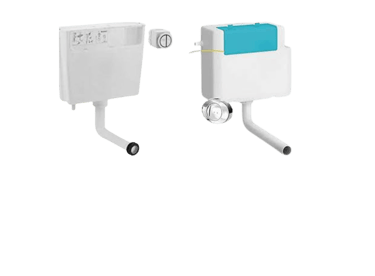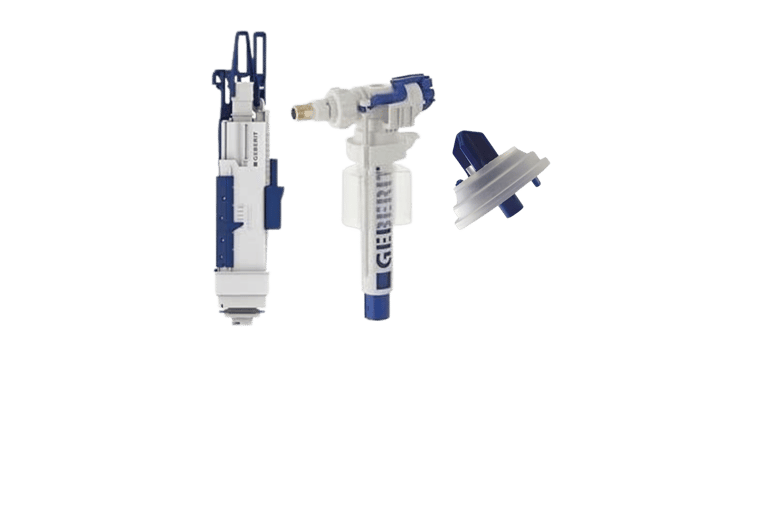
Cisterns
Not all cisterns are equal, some are designed for use exterior of the wall, some for use in furniture, others for behind a wall , view the options below


Low Height & Furniture Cisterns




Wall Hung & Concealed Cisterns
Cistern Spares
The Ultimate Guide to Toilet Cisterns: Close Coupled, Back to Wall, and Wall Hung Explained
Choosing the right toilet cistern is more important than you might think. It plays a key role in both the functionality and aesthetics of your bathroom. Whether you're a homeowner embarking on a DIY project or just looking to update your bathroom, understanding the different types of toilet cisterns can make all the difference.
In this guide, we'll break down the main types of toilet cisterns available: close coupled, furniture back to wall, behind the wall back to wall, and wall hung. By the end, you'll know which type best suits your needs, from space-saving designs to sleek, modern looks. Let's get started on transforming your bathroom into a more efficient and visually pleasing space.
Understanding Toilet Cisterns
A toilet cistern is a crucial component of any bathroom setup, one that often goes unnoticed until it stops working properly. Essentially, the cistern is the tank that stores water for flushing. It is typically located behind or above the toilet bowl, and its main role is to release a set amount of water into the bowl to wash away waste. But there’s more to it than just holding water – the cistern ensures efficient waste removal with each flush while conserving water.
There are several types of toilet cisterns, each with its unique advantages and design considerations. Here’s an overview of the main types we'll be diving into:
Close Coupled Cisterns
Close coupled cisterns are one of the most common types found in homes. In this setup, the cistern is directly attached to the toilet bowl you may know this as a 2 piece toilet , forming a single, compact unit. This not only saves space but also makes installation easier and more cost-effective. These cisterns are popular due to their sleek, modern look and efficiency.
Furniture Back to Wall Cisterns
With furniture back to wall cisterns, the cistern is concealed within a piece of bathroom furniture or cabinetry. This design is perfect for maintaining a seamless and tidy bathroom aesthetic. It also provides additional storage space and a minimalist look, as the cistern is hidden from view.
Behind the Wall Back to Wall Cisterns
Behind the wall back to wall cisterns involve fitting the cistern within the bathroom wall. This type of cistern requires more complex installation and initial planning but offers a very clean and streamlined finish. Since the mechanism is hidden, it can make for a quieter flush and a more spacious bathroom environment.
Wall Hung Cisterns
Finally, wall hung cisterns are ideal for a contemporary bathroom. These cisterns are mounted within the wall, allowing the toilet bowl to be suspended above the floor. This not only creates a modern look but also makes cleaning easier. Wall hung systems can often be adjusted in height, providing a more customised experience for users.
In the following sections, we will discuss each type in detail, considering their pros and cons, installation insights, and style tips to help you make a well-informed decision for your home.
Next up, let's take a closer look at close coupled cisterns.
Close Coupled / 2 Piece Toilet Cisterns
Close coupled or 2 Piece cisterns are a popular choice for many homeowners, thanks to their practical design and ease of use. In this section, we will explore the design and structure of these cisterns, their advantages, and a few potential important things to note.
Design and Structure
Close coupled toilet cisterns are designed for simplicity and efficiency. The cistern sits directly on the back of the toilet pan, forming a single, compact unit. This close connection between the cistern and the bowl allows water to flow smoothly from the tank to the bowl, ensuring a thorough and effective flush.
Advantages
Close coupled cisterns come with several benefits that make them a go-to option for many households:
Ease of Installation: These units are relatively straightforward to install. Since the cistern and bowl are directly connected, it simplifies the plumbing and reduces installation time.
Maintenance: Maintenance is generally easier and more cost-effective. Accessing the cistern doesn’t require removing the entire toilet, which saves on repair costs and time.
Space-Saving: The compact design of close coupled cisterns makes them ideal for smaller bathrooms. They don’t take up much room, which is great for homes with limited space.
Cost-Effective: Because they are easier to install and maintain, these cisterns typically come at a lower cost compared to other types. This can be a significant factor for budget-conscious homeowners.
To explore various models and designs, check out here
Disadvantages
However, no solution is without its drawbacks. Close coupled cisterns have a few potential downsides to consider:
Aesthetic Limitations: While practical, the design of close coupled cisterns might not appeal to everyone. Their somewhat bulky appearance can be less aesthetically pleasing compared to more modern, streamlined designs.
Cleaning Challenges: The area where the cistern meets the toilet bowl can be tricky to clean. Dust and grime can accumulate in these nooks, requiring more diligence in cleaning.
Noise: Close coupled cisterns can sometimes be slightly noisier when refilling, which might be a minor inconvenience in quiet households, but the fact these types of cisterns remain so popular should tell you, it's not an issue for most people.
.
By understanding the design, advantages, and disadvantages of close coupled cisterns, you can make a more informed choice for your bathroom needs.
Furniture Back to Wall Toilet Cisterns
Furniture back to wall toilet cisterns offer a sleek and modern solution for those looking to maintain a seamless bathroom aesthetic. These cisterns are incorporated into bathroom furniture units, providing both functionality and an attractive appearance.
Design and Structure
Furniture back to wall cisterns are designed to be installed within bathroom furniture units. This allows them to be completely hidden from view. The unit itself appears as a single piece of furniture, with only the toilet bowl visible. This helps create a seamless and streamlined look in any bathroom.
The installation involves placing the cistern inside a specially designed piece of furniture, such as a vanity unit or a WC unit. This method not only conceals the cistern but also hides the pipework, which can often look unsightly. This blend of design and functionality makes these cisterns a popular choice for modern bathrooms.
Advantages
Choosing a furniture back to wall cistern comes with several notable benefits:
Improved Aesthetics: By hiding the cistern and plumbing, the bathroom furniture unit offers a much tidier and pleasing look. This can transform even the most unappealing bathroom setups into something stylish.
Space-Saving: The furniture unit can often double up as additional storage space. This is incredibly useful in smaller bathrooms where space is at a premium.
Ease of Maintenance: Having the cistern behind a furniture unit makes it easier to access for maintenance compared to units that are built into walls.
Versatility in Design: These units come in various designs and finishes, allowing homeowners to choose something that matches their bathroom decor perfectly.
Disadvantages
While furniture back to wall cisterns offer numerous pros, they also have some potential downsides to consider:
Slightly Cost: These units tend to be more expensive than traditional cisterns. The cost can rise due to the need for additional furniture and, sometimes, custom designs.However, this isn't strictly necessary and will ultimately be determined by your budget and style choice.
Installation: Installing these types of cisterns usually requires a little more thought process . DIY enthusiasts might find the installation process slightly more challenging compared to standard cisterns, but any professional fitter worth their salt will have no issue with the installation of these.
Bulkier Appearance: Although aesthetically pleasing, the furniture units can sometimes take up more space than other types of cistern installations. This might not be ideal for very small bathrooms where every inch counts.
Furniture back to wall toilet cisterns combine practicality with aesthetics, making them an excellent choice for many homeowners. By understanding both the advantages and disadvantages, you can decide if this type of cistern is the right fit for your bathroom.
Behind the Wall Back to Wall Toilet Cisterns
Behind the wall back to wall toilet cisterns are a fantastic choice if you're aiming for a sleek and modern bathroom look. These cisterns are installed within the wall behind the toilet bowl, creating a clean and minimalist appearance.
Design and Structure
Behind the wall back to wall cisterns are designed to be entirely concealed within your bathroom wall. This means that the cistern, which holds and releases water for flushing, is hidden from view. Only the flush plate is visible on the wall, resulting in a streamlined and uncluttered look.
The installation process involves fitting the cistern within a specially constructed wall cavity or a pre-built frame. This can be done during a bathroom renovation or new build, as it requires precise planning and construction. Because the mechanism is hidden, it often results in a quieter flush compared to traditional systems.
For more details, you can explore concealed cisterns which provide insights on design and structure.
Advantages
Behind the wall back to wall cisterns offer several benefits, making them an increasingly popular choice:
Minimalistic Appearance: The primary advantage of these cisterns is their ability to create a clean, modern, and minimalistic bathroom look. With the cistern hidden, your bathroom appears less cluttered and more open.
Easier Cleaning: Because the cistern and much of the plumbing are hidden, there are fewer surfaces exposed to dust and grime, making bathroom cleaning simpler and quicker.
Space-Saving Design: This setup can save space, particularly in smaller bathrooms. By hiding the cistern within the wall, you make better use of the available area.
Quieter Operation: The noise of the cistern refilling is often muffled by the wall, leading to a quieter bathroom environment.
To delve deeper into these benefits, you can check out back to wall cisterns.
Disadvantages
While behind the wall back to wall cisterns offer many advantages, they also come with a few potential downsides:
Access for Repairs ? : This isn't even a disadvantage and is a common misconception, I just wanted to address it here, access to the cistern and all the parts is extremely easy , if it's in furniture you have a panel that can be removed easily, if it's in a wall you access everything through the flush plate ,meaning any repairs can be done quickly, parts are readily available online and once you know how, you will see how easy it is to repair or maintain, these videos here show how it's done, and in the comments you see how many have benefitted from it
Higher Installation Costs:There's no getting away from it, Installing these cisterns typically comes at a higher cost than installing a close coupled . The installation process is slightly more complicated and once you've bought, the pan and flush plate it will be more expensive , however , it is not 'silly' money by any means and does offer great value for money to get the look you want for you bathroom.
Renovation Limitations: If you're renovating an existing bathroom, modifying the wall to accommodate the cistern can be challenging. You may need to put up a false wall to hide it behind or create a unit for it to be set in, none of these are the end of the world, but they need to be considered in your budget.
By understanding the design, advantages, and disadvantages of behind the wall back to wall cisterns, you can better decide if this type of cistern is the right fit for your bathroom upgrade.
Wall Hung Toilet Cisterns
Wall hung toilet cisterns bring a sleek and contemporary feel to any bathroom. Their unique design, combined with practical advantages, makes them a popular choice for modern homes.
Design and Structure
Wall hung toilets are a marvel of modern design and engineering. The cistern, which is the component that holds the flushing water, is concealed within the wall, while the toilet pan is suspended above the floor. This not only gives the bathroom a cleaner and more spacious appearance but also hides the mechanics for a more minimalist look.
For those who appreciate clean lines and a clutter-free space, wall hung toilets provide an ideal solution. The installation involves placing the cistern inside a specially constructed frame within the wall. This frame supports the weight of the toilet pan and ensures it stays securely in place.
Advantages
Wall hung toilet cisterns offer several benefits that make them a smart choice for homeowners:
Modern Aesthetics: Wall hung toilets provide a sleek, contemporary look. By concealing the cistern and mounting the toilet pan off the floor, these toilets create an open and airy feeling in the bathroom.
Easier Cleaning: Cleaning under and around the toilet becomes a breeze since there’s no base touching the floor. This design prevents dust and grime from accumulating in hard-to-reach places, making bathroom maintenance simpler and more effective.
Space-Saving Design: These toilets are a great option for smaller bathrooms or en-suites. By hiding the cistern within the wall, they save valuable floor space, which can be used for other fixtures or simply to make the room feel larger.
Adjustable Height: Wall hung toilets can be installed at a height that suits individual needs. This flexibility offers enhanced comfort, particularly for people with mobility issues or taller individuals.
Disadvantages
Despite their numerous benefits, wall hung toilets also come with some potential downsides:
Need for Strong Wall Support ? : This is more about the quality of installation than the walls ,Wall Hung frames are tested to huge weights meaning they can support up to 400kg , they also offer a wide range of items that allow you to fix the frame too, so you can fix back to solid walls, within a wooden frame or even to a stud wall!, see more here, the fact is ,a wall hung frame offers a multitude of ways to be fitted, you just need to ensure you have the correct fixings and an installer capable of doing it.
Higher Installation Costs: Installing a wall hung toilet is generally more expensive than traditional models. The process is more involved, often requiring professional installation and potentially more time and materials
Maintenance and Repairs: As I mentioned in the back to wall section , This isn't even a disadvantage and is a common misconception, access to the cistern and all the parts is extremely easy , you access everything through the flush plate ,meaning any repairs can be done quickly and easily, parts are readily available online and once you know how, you will see how easy it is to repair or maintain, these videos here show how it's done, and in the comments you see how many have benefitted from it
By understanding the design, advantages, and disadvantages of wall hung toilet cisterns, you can decide whether this modern fixture is the right fit for your bathroom renovation.
Comparison of Different Toilet Cisterns
Selecting the right toilet cistern for your bathroom can significantly impact both the look and function of the space. Each type of cistern has its unique advantages and considerations in terms of cost, installation, aesthetics, and space efficiency. Let's break down these aspects to help you make an informed choice.
Cost
When comparing the costs of different toilet cistern types, both purchase and installation expenses play a crucial role.
Close Coupled Cisterns are typically the most affordable option. They are mass-produced and readily available, making them cost-effective. Installation costs are also lower since they require less labour and materials.
Furniture Back to Wall Cisterns are moderately priced when considering the combined cost of the cistern and the enclosing furniture unit. However, the added furniture piece can make the overall cost higher. Installation might also be pricier due to the need to fit the unit correctly.
Behind the Wall Back to Wall Cisterns can be more expensive. The cost includes the cistern itself an. Installation costs can be slightly higher due to the complexity of fitting the cistern within the wall, But this really is a pretty standard installation these days for any professional installer .
Wall Hung Cisterns are among the most expensive options. The price includes the wall hung frame with cistern, flush plate and toilet. Installation is also costlier, requiring precise work to ensure stability and proper function.
Installation and Maintenance
The ease of installation and maintenance can greatly affect your choice of toilet cistern.
Close Coupled Cisterns are easy to install and maintain. Since the cistern is directly attached to the toilet bowl, there’s no need for specialised fitting. Maintenance is straightforward as the cistern is easily accessible.
Furniture Back to Wall Cisterns require more effort to install because the cistern needs to be integrated into a furniture unit. However, maintenance is simpler than other concealed options, as the furniture can be designed with access panels.
Behind the Wall Back to Wall Cisterns are slightly more complex to install. The cistern must be fitted within the wall, which can mean alteration to existing structures. Maintenance is easy through the flush plate
Wall Hung Cisterns can mean a slightly longer installation process. A supporting frame must be fixed inside the wall, and the cistern concealed within it. Once fitted correctly maintenance is simple through the flush plate.
Aesthetics
The visual appeal of your toilet cistern can dramatically influence your bathroom’s overall look.
Close Coupled Cisterns offer a traditional and somewhat bulky appearance. While not the most modern option, they blend well with many bathroom styles.
Furniture Back to Wall Cisterns provide a streamlined and tidy look. By hiding the cistern in a furniture unit, they contribute to a seamless bathroom design, adding a touch of elegance.
Behind the Wall Back to Wall Cisterns create a very modern and minimalistic look. With the cistern and plumbing concealed within the wall, only the toilet bowl and flush button are visible, enhancing a clean and uncluttered appearance.
Wall Hung Cisterns offer an ultra-contemporary feel. The toilet bowl is suspended above the floor, making the bathroom appear more spacious and modern. This design is particularly favoured in high-end and designer bathrooms.
Space Efficiency
How each type of cistern utilises bathroom space can impact its suitability for small or large bathrooms.
Close Coupled Cisterns are compact and take up minimal space, making them ideal for smaller bathrooms. However, they do not offer any additional storage or space-saving benefits.
Furniture Back to Wall Cisterns can be space-efficient as the furniture unit can provide extra storage. They are suitable for both small and large bathrooms, offering functionality and design.
Behind the Wall Back to Wall Cisterns save significant floor space as the cistern is hidden within the wall. This makes them an excellent choice for tight spaces where every inch counts.
Wall Hung Cisterns also save floor space by suspending the toilet bowl above the ground. This not only makes the bathroom feel larger but also makes cleaning easier. They are suitable for any bathroom size, especially for smaller spaces where a minimalist design is needed.
By carefully weighing the cost, installation and maintenance needs, aesthetics, and space efficiency, you can choose the perfect toilet cistern for your bathroom.
Conclusion
Choosing the right toilet cistern can transform the functionality and aesthetics of your bathroom. Close coupled cisterns are cost-effective and easy to install, making them ideal for smaller spaces and tight budgets. Furniture back to wall cisterns offer a seamless look while providing additional storage space, perfect for maintaining a tidy bathroom. Behind the wall back to wall cisterns create a minimalist appeal but require more complex installation and maintenance. Wall hung cisterns offer a modern, space-saving solution, although they come with higher installation costs and maintenance challenges.
Consider your specific needs, bathroom size, and design preferences when selecting a cistern. For budget-friendly options, close coupled cisterns are a practical choice. If aesthetics and storage are priorities, furniture back to wall cisterns are a great fit. For a sleek and minimalist look, behind the wall or wall hung cisterns are worth the investment. Your choice should reflect a balance between functionality, aesthetics, and budget to create the perfect bathroom experience.
Explore latest trends and innovations in bathroom industry.
News
Videos
sales@plumbsolutions.uk
© 2024. All rights reserved.
Cookies
